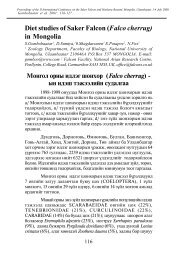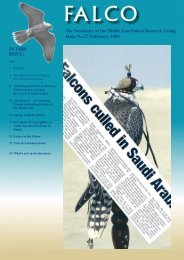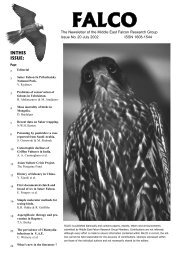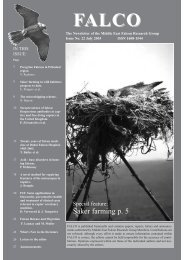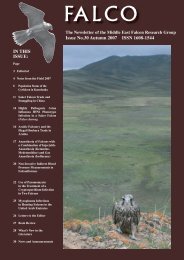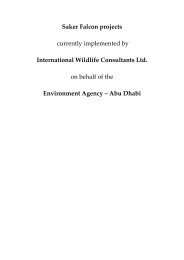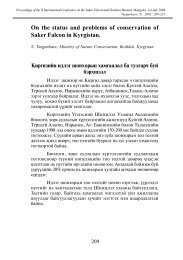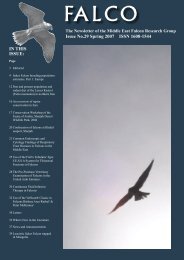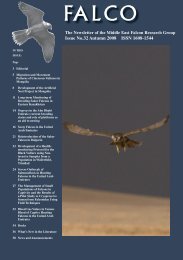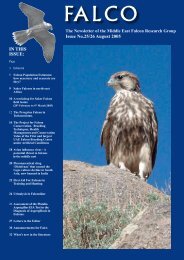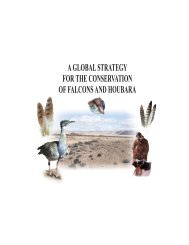Falco cherrug - International Wildlife Consultants Ltd.
Falco cherrug - International Wildlife Consultants Ltd.
Falco cherrug - International Wildlife Consultants Ltd.
You also want an ePaper? Increase the reach of your titles
YUMPU automatically turns print PDFs into web optimized ePapers that Google loves.
No Boundaries” which became a great success, even in<br />
these days of conflict and aggression. A Website was developed<br />
- www.birds.org.il - and about 260 schools from Israel,<br />
Jordan and the Palestine Authority follow migrating birds of<br />
prey, storks and cranes with satellite transmitters andx online<br />
radar data, and the students use a curriculum to learn<br />
about conservation problem of migrating birds. The six<br />
years project was sponsored by US-AID, MERC. With the<br />
help of the UNESCO World Heritage Centre, UN<br />
Foundations, UNEF and other global organizations we are<br />
trying to initiate a new concept to get together 22 countries<br />
along the entire Great Rift Valley, and to develop the same<br />
concept from a regional to a global level, including more<br />
important issues to protect the world’s nature and culture<br />
heritage.<br />
Horowutz, I., Bellaiche, M. and Shlosberg, A. 2003.<br />
Safety of Atropine and 2-PAM in Birds. Proceedings of<br />
the 6th Raptor World Conference in Budapest,<br />
Hungary.<br />
Organophosphorus and carbamate insecticides are<br />
commonly used in Israel and over much of the world.<br />
Raptors at the top of the food chain are especially susceptible.<br />
In birds, these life-threatening anticholinesterase toxicants<br />
present clinical signs that can resemble other bird diseases,<br />
in contrast to mammals where the symptoms are clear<br />
and often diagnostic. Precise and rapid diagnosis and the<br />
correct antidote can save the intoxicated bird. However<br />
when wild birds are found with a suspicion of intoxication,<br />
there is often a prolonged timelag until they can be brought<br />
to a hospital or rehabilitation center for laboratory tests and<br />
treatment. When potentially fatal intoxication is suspected<br />
in the field, it would be useful to have immediate first aid<br />
treatment with a safe antidote. This study investigates the<br />
safety of very high dosages (compared to mammals) of the<br />
antidotes atropine and 2-PAM. Non-poisoned raptors,<br />
which were designated for euthanasia for various health reasons,<br />
were injected with high levels of the antidotes with no<br />
clinical signs manifested. The significance of this for first<br />
aid treatment in the field is paramount. It means that when<br />
a suspected intoxicated bird is found, the antidotes can be<br />
administered safely with no additional harm to the bird,<br />
even before receiving the toxicology diagnosis. Verification<br />
of the impact of atropine and 2-PAM on various organs of<br />
the bird, was examined in three domestic bird species. The<br />
analysis consisted of measuring blood enzyme changes after<br />
the treatment. There were no significant changes that could<br />
show organs’ damage.<br />
Risebrough, R.W. 2003. Population Collapses of Three<br />
Species of Gyps Vultures in the Indian Subcontinent: An<br />
Overview. Proceedings of the 6th Raptor World<br />
Conference in Budapest, Hungary.<br />
Only a disease factor new to the host populations,<br />
or a genetic modification of a previously benign factor, can<br />
adequately explain the pattern of mortalities and population<br />
collapses of three species of Gyps vultures in the Indian<br />
Subcontinent. Circumstantial evidence suggests a beginning<br />
as early as the late 1980s. A western movement into<br />
Pakistan has been documented since 2000 and the decline<br />
appears to have occurred later in north-eastern India than in<br />
northern and central India. The local eradication of host<br />
populations by newly-arrived disease factors is a rare event,<br />
but extinction must be considered as a possible outcome of<br />
the present endemic. The information obtained in current<br />
research programs and from observations of vultures<br />
throughout the Subcontinent might therefore be carefully<br />
evaluated for evidence that small healthy populations of<br />
each of the three species have survived and are no longer<br />
subject to high mortality rates. In the absence of such information,<br />
artificial incubation of eggs laid in the wild in two<br />
or more facilities appears now to be the fallback position<br />
among conservation priorities, in spite of the possibility that<br />
the eggs may not be free of the disease factor. Young birds<br />
produced at such facilities might then be distributed among<br />
other institutions for captive breeding.<br />
Gilbert, M., Virani, M.Z, Watson, R., Oaks, J.L.,<br />
Ahmed, S., Chaudhary, J. Arshad, M. Mahmood, S., Ali,<br />
M. and Khan, A.A. 2003. The decline of the Oriental<br />
White-backed Vulture, Gyps bengalensis in Punjab<br />
Province, Pakistan: a three-year update. Proceedings of<br />
the 6th Raptor World Conference in Budapest,<br />
Hungary.<br />
Declines in the populations of the Gyps vultures of<br />
the Indian subcontinent have been widely documented;<br />
however, little data has been presented on the rates and patterns<br />
of mortality at vulture breeding sites over time. This<br />
long-term study aims to address this deficit by providing<br />
data on the mortality rates and patterns through the continuous<br />
monitoring of three large colonies of Oriental Whitebacked<br />
Vultures Gyps bengalensis (n=758, 413, 445 breeding<br />
pairs in 2000) within the Punjab Province, Pakistan,<br />
over consecutive breeding seasons. The activity and productivity<br />
of nests within fixed study sites was determined<br />
over three breeding seasons. All dead vultures were collected<br />
and removed from transects during the breeding and nonbreeding<br />
seasons. Mortality of adult vultures at each site has<br />
continued at a rate indicative of a population in decline.<br />
Numbers of active nests at the three study colonies have<br />
declined by 33%, 88% and 97% from the 2000/01 –<br />
2002/03 nesting seasons.<br />
Prakash, V., Pain, D.J. and Cunningham, A.A. 2003.<br />
The “Vulture Rescue” Team’s Conservation<br />
Programme. Proceedings of the 6th Raptor World<br />
Conference in Budapest, Hungary.<br />
Monitoring of White-backed (Gyps bengalensis) and<br />
Long-billed (Gyps indicus) vultures at the Keoladeo National<br />
Park World Heritage Site by the BNHS throughout the 1980s<br />
and early 1990s showed a >95% decline (Prakash 1999). At the<br />
request of BNHS, RSPB sponsored scientists from ZSL to visit<br />
India in 1999 & 2000 to evaluate the situation. Repeat nationwide<br />
surveys by BNHS supported by RSPB in 2000 showed a<br />
similar situation to be present throughout India (Prakash et al.<br />
2003). RSPB-supported surveys by Bird Conservation Nepal<br />
indicate that the same problem has occurred in Nepal. Results<br />
from studies by the BNHS suggest the declines in India do not<br />
result from food shortage, habitat loss or persecution. In 2001,<br />
a consortium consisting of BNHS and the Poultry Diagnostic &<br />
Research Centre in India, and the RSPB, ZSL (IoZ) and the<br />
NBPC in the UK, obtained British Government funding to (i)<br />
21



